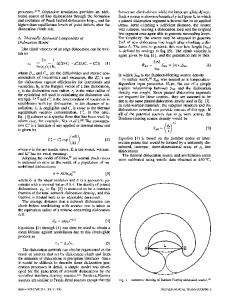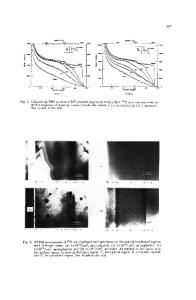Modeling Threading Dislocation Loop Nucleation and Evolution in MeV Boron Implanted Silicon
- PDF / 62,744 Bytes
- 6 Pages / 612 x 792 pts (letter) Page_size
- 60 Downloads / 426 Views
Modeling Threading Dislocation Loop Nucleation and Evolution in MeV Boron Implanted Silicon Ibrahim Avci1 and Mark E. Law Craig Jasper2, Hernan A. Rueda and Rainer Thoma 1 Swamp Center, Department of Electrical Engineering, NEB Room # 535, University of Florida, Gainesville FL 32601 2 Motorola, Digital DNA Laboratories, Mesa, AZ 85202. ABSTRACT A single statistical point defect based model for the nucleation and evolution of dislocation loops during annealing in Si is developed. The model assumes that the radius and the density of dislocation loops follow a log normal distribution. The loop nucleation part of the model also assumes that all the loops come from {311} unfaulting. The model is verified with the experimental results obtained by studying the formation of dislocation loops and threading dislocation loops as a function of implant condition in boron implanted silicon by varying the dose from 1×1013 to 5×1014 cm-2 at an energy of 1.5 MeV. Due to the statistical nature of the model, the threading dislocation loop density is easily obtained from simulation results. The dramatic change in the threading dislocation loop density with the increasing implant dose is also predicted by the simulations. INTRODUCTION High energy non-amorphizing implants are commonly used in integrated circuit (IC) manufacturing. The main advantages of ion implantation are to introduce a desired impurity into a target material, accurate dose control, reproducibility of the impurity profiles, lower process temperatures and the ability to tailor the doping profile [1]. They are commonly used to form retrograde wells for CMOS latch-up immunity improvement and buried layers for bipolar transistor subcollectors [2-4]. However, heavy lattice damage can be generated near the projected range of the implanted dopant [5]. The defects near this region are typically interstitial in nature and will evolve in threading dislocation loops (TDL), {311}s [6-8] and stable dislocation loops. The threading dislocation loops are long dislocation dipoles that can grow to the surface and thread the surface [8]. If these defects are located in the active device region, they can cause leakage currents and be detrimental to the electrical properties of the device [9]. Understanding and modeling of the unique material aspects of damage/defect accumulation during very high energy implantation and subsequent annealing cycle is critical in improving the device performance. A model would also help device/process engineers to change and adjust their device structures and process conditions without having to build costly test lots. In this article we explain a model for the nucleation and evolution of dislocation loops. Using this model, threading dislocation loop density is derived from simulation results. Simulation results have been validated against experimental data [10]. The results are in good agreement with the data. The threading dislocation loop density increases with increasing implant dose to a maximum at a dose of 1×1014 cm-2 and decreases with the increasi
Data Loading...




